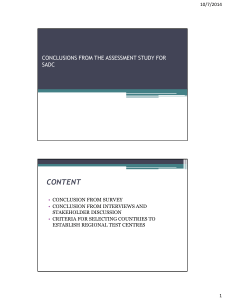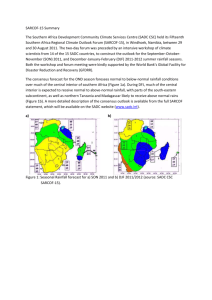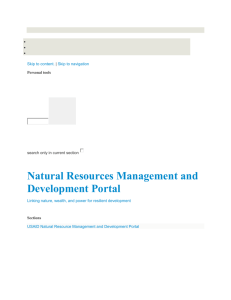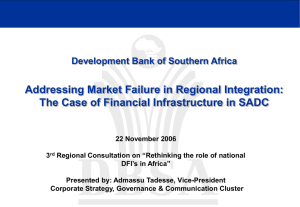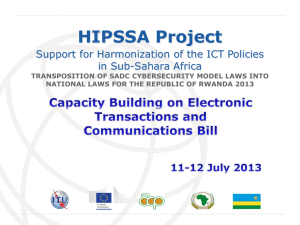AN OVERVIEW SADC STATISTICS PROGRAMME IN THE CONTEXT OF THE RISDP BY
advertisement
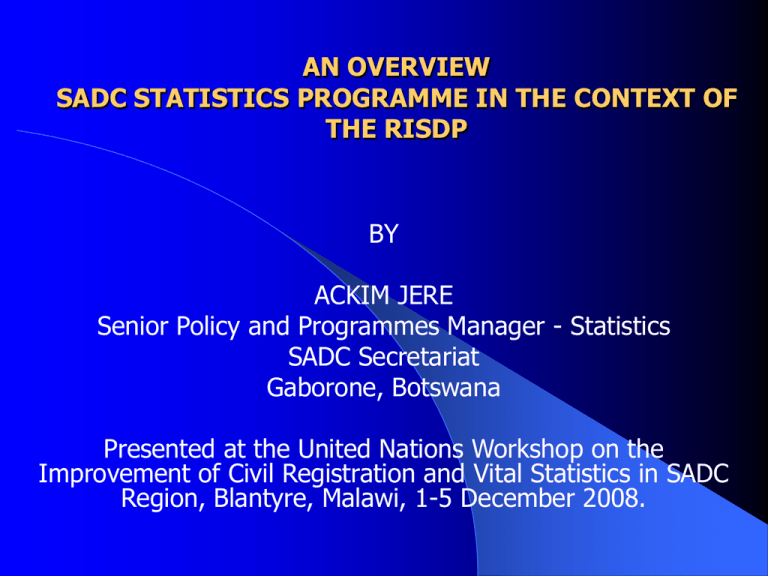
AN OVERVIEW SADC STATISTICS PROGRAMME IN THE CONTEXT OF THE RISDP BY ACKIM JERE Senior Policy and Programmes Manager - Statistics SADC Secretariat Gaborone, Botswana Presented at the United Nations Workshop on the Improvement of Civil Registration and Vital Statistics in SADC Region, Blantyre, Malawi, 1-5 December 2008. SADC REGIONAL STATISTICAL PROGRAMME IN CONTEXT OF RISDP Introduction The RISDP and the SADC Statistics Programme New SADC Secretariat Organizational Structure SADC Institutional Framework. SADC Statistics Programme Recent SADC Statistical Projects and Initiatives Progress under the SADC Statistics Programme Major Challenges for the SADC Statistics Programme Conclusion INTRODUCTION SADC was established at the Summit of Heads of State and Government on 17 August 1992 in Windhoek, Namibia. SADC currently composed of 14 member states, namely, Angola, Botswana, DRC, Lesotho, Madagascar, Malawi, Mauritius, Mozambique, Namibia, South Africa, Swaziland, Tanzania, Zambia, and Zimbabwe SADC Secretariat in Goborone, Botswana SADC Mission: “To promote sustainable and equitable economic growth and socio-economic development through efficient productive systems, deeper co-operation and integration, good governance, and durable peace and security, so that the region emerges as a competitive and effective player in international relations and the world economy The SADC RISDP and the SADC Statistics Programme The SADC Regional Indicative Strategic Development Plan (RISDP) adopted by summit in Arusha, Tanzania in 2003 What is RISDP? The SADC Regional Indicative Strategic Development Plan (RISDP) is a 15 year regional integration development framework, setting the priorities, policies and strategies for achieving the long-term goals of the SADC. It is intended to guide member states, SADC Institutions, regional stakeholders, international cooperating partners in the process of deepening integration to turn the Community’s vision into reality. RISDP Statistics Intervention Areas Statistics fully acknowledged in the RISDP as one of the cross cutting issues; Four Intervention areas identified in the SADC RISDP for statistics: (1) (2) (3) Development of a legal framework in Statistics; Harmonization of Statistics in the SADC region; Provision of relevant Statistics for regional integration; and (4) Statistical Capacity building development in SADC. New SADC Secretariat Organizational Structure New SADC Secretariat organizational structure approved by the SADC Council of Ministers on 25th February 2005 in Grand Baie, Mauritius Operationalisation of Structure from April 2005; Structure Comprises of the following four Directorates: Trade, Industry, Finance and Investment (TIFI); Food, Agriculture and Natural Resources (FANR); Infrastructure and Services (IS); and Social and Human Development, and Special Programmes (SHD). In addition there are Units including the following: Policy and Strategic Planning, Legal Affairs, Finance; and Gender. Statistics under the Policy and Strategic Planning unit in the office of the Executive Secretary SADC Institutional Framework. The Council of Ministers is responsible for overseeing the functioning and development of SADC and ensuring that policies are properly implemented. This also provides the context for the development of the Statistical system in the SADC region. The Integrated Committee of Ministers (ICM) is the clearing house for the Council of Ministers regarding all matters. SADC Secretariat is the executive wing of SADC and is responsible for strategic planning and management of SADC programmes including statistical programmes. SADC Institutional Framework (Cont’d) SADC Secretariat Vision: A reputable, efficient and response enabler of regional integration and sustainable development. SADC Secretariat Mission: To provide strategic expertise and coordinate the harmonization of policies and strategies to accelerate regional integration and sustainable development SADC Institutional Framework (Cont’d) SADC Secretariat Values: o o o o o o o o o Quality Service and Competency; Professionalism; Integrity; Commitment and Passion; Team Spirit; Mutual Respect and Trust; Courtesy; Equality of Opportunity; and Transparency. SADC Statistical System The SADC Statistical System is the collective set up of the following: – National Statistics Systems of the Member States, – Statistics Programme at the SADC Secretariat, – SADC Statistics Committee, and; – other related mechanisms that support these structures. SADC Statistics Committee (SSC). Established 1995 in Windhoek by Council of Ministers; Directors or Heads of National Statistics Offices of the member states bona fide members of the Committee but other key statistical stakeholders such as Reserve/Central Banks and cooperating partners sometimes participate in meetings of the Committee; SADC Statistics Committee (Cont’d) Terms of Reference for the SSC include the following: to define the role of statistics in the integration process; development of SADC Statistical Programme; to oversee the implementation of the programmes in the SADC Statistical System; to set priorities for statistical development (including training) in SADC; mobilization of resources for the implementation of the SADC Statistical programme; development of protocols or legal instruments providing for uniform approaches to the implementation of the SADC Statistical System; facilitation of secondment of regional statisticians among the member states; and seek at achievement of the comparability, standardization and harmonization of statistical systems and policies in the SADC region. SADC Statistics Focal Points Subject Matter Informal Sector Surveys Focal Point Botswana Censuses and Population South Africa National Accounts Mozambique Investment Statistics Tanzania Economic Classifications Zimbabwe Foreign Trade Statistics Zambia SADC Statistics Programme The overall objective of the SADC Statistical Programme is to support regional integration by making available relevant, timely and accurate statistical information to be used in SADC planning, policy formulation, protocol monitoring and decision-making. SADC Statistics Programme aims at achieving the following; The Harmonization of statistical concepts, definitions and methods among member states; Coordination of regional statistics (National Accounts, Foreign Trade, Population, Prices, Gender, Agriculture, Education, Employment etc) development programmes; Customisation of international and other regional statistical classifications, definitions and standards to SADC; Enhancement and promotion of capacity building (including training) of National statistical systems; SADC Statistics Programme (Cont’d) Collection, processing, storage and dissemination of National statistical data and collation into relevant and reliable regional statistics; and Development and Management of an integrated regional statistical SADC Statistics Programme (Cont’d) Under the New SADC Secretariat Organization Structure: SADC Statistics Programme has four positions for statistical personnel namely: (1) (2) (3) (4) Senior Policy and Programmes Manager; Trade Statistics Officer; Macroeconomics Statistics Officer; Social and Human Development Statistics Officer; As at April 2006 two positions of Senior Policy and Programmes Manager and Trade Statistics Officer are filled. Positions (3) and (4) still frozen and awaiting results of job evaluation exercise Recent SADC Statistical Projects and Initiatives Statistical projects and initiatives undertaken in SADC in recent years include: SADC/EU Statistical Training Project aimed at the enhancement of human resource capacity for the co-ordination, production and utilization of official statistics that are required in support of priority policies (in Protocols and other key agreed areas) of SADC and Member states.” On-going and expected to end in December 2007 SADC/EU Price Statistics Project aimed at harmonizing the production of Consumer Price indices in the SADC. Implemented from 2002-2006 Statistical Capability Building for Poverty Reduction Strategies project financed by the World Bank whose main objective is to support development capacity for the establishment of National Poverty Reduction strategies in the SADC member states. Implemented from 2002-2006 Recent SADC Statistical Projects and Initiatives (Cont’d) SADC Millennium Census Data Analysis Project whose main aim was improvement of the analytical capacity for analyzing Population Census data in the member states. The project received financial support from Rockefeller Foundation and officially ended December 2005. Successor Project envisaged Harmonization of Trade Statistics to, among other things, support the implementation of the SADC Trade protocol for purposes of boosting trade among the member states and between SADC and other regions of the world. On-Going. International Comparison Program Development Bank. On-Going. ICP- financed through the Africa Recent SADC Statistical Projects and Initiatives (Cont’d) SADC- UNSD Development Account Project whose overall objective is to strengthen capacity of member states and regional institutions in SADC for the production and analysis, on a regular basis, of benchmark statistics required for national development planning and for monitoring of progress of internationally agreed development goals, including the MDGs, and to enhance intra-regional cooperation among the national statistical systems and the SADC Secretariat. Launched July 2006 and on- going for 4 years. Progress under the SADC Statistics Programme On going activities relating to harmonization of Trade Statistics; Initiation of the development of a concept paper for the eventual development of the SADC Statistics Protocol. Terms of Reference for Consultancy developed and circulated for comments; Enhancement of earlier initiatives towards the development of a sustainable regional statistical database. Live database; On going capacity building initiatives for harmonization of statistical process and methodologies under the auspices of the particularly the following projects; SADC Statistics Training Project; SADC Price Statistics Project; Census Analysis Project; and SADC/World Bank capacity building project for poverty reduction strategies Progress under the SADC Statistics Programme (Cont’d) Need to fast track the filling of two statistics staff positions in the SADC Secretariat imperative to sustain the tempo or progress achieved within the SADC Statistics Programme Major Challenges for the SADC Statistics Programme The audits of National Statistical Systems in SADC member states undertaken under the auspices of the RSTP provide empirical evidence of the following as major challenges: – Inadequate resources allocated to statistics in some of the member – – – – – countries; Disparities in the statistical capacity among the countries; Inadequate statistical capacity at the Secretariat to co-ordinate statistical activities in the region; Absence of a legal instrument for regional cooperation in the area of statistics; Lack of effective dissemination mechanisms (including databases and connectivity); and; Long time lag between collection of data and dissemination of statistics. OUTLOOK FOR FUTURE STATISTICS PROJECTS Future projects in statistics in SADC should aim to address the key concerns and priority areas as spelt out in the RISDP if the statistics are to be relevant to the SADC development agenda; Launch of capacity building programmes in future should ensure the need to address harmonisation of statistics and for enhancement of capacity for production and utilisation of official statistics; Future statistics development initiatives in SADC to be undertaken in compliance with international standards and frameworks such as the United National Fundamentals for Official statistics and the Reference Regional Statistical Framework (RRSF) adopted by the FASDEV II meeting held in Addis Ababa, Ethiopia from 9-10 February 2006. Conclusion The success of the SADC Statistics Programme depends on the responsiveness of the national statistics systems of the member states. In this regard it is important that statistical capacity building programmes are further promoted to enhance capacity for the production, analysis and dissemination of official statistics in the member states. THANK YOU OBRIGADO MERCI
